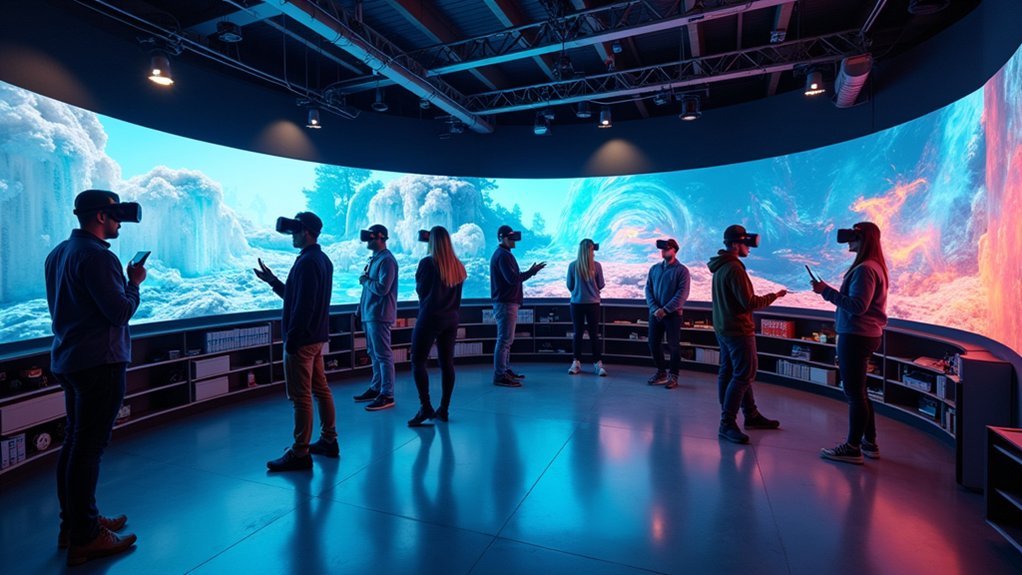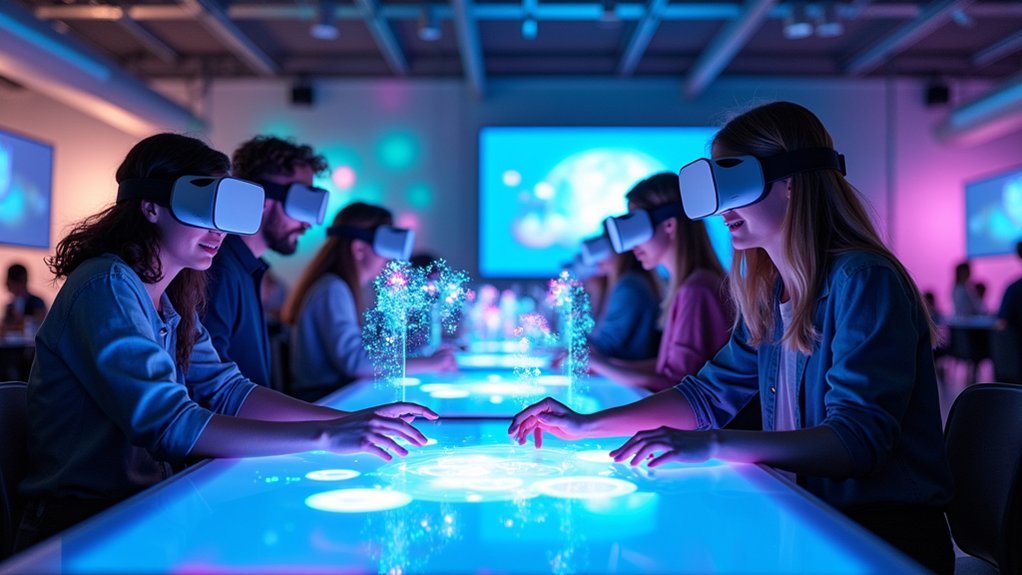You’ll need to select a compatible platform like Unity or Unreal Engine that supports major VR devices and OpenXR standards for cross-platform functionality. Focus on implementing real-time user synchronization, spatial audio systems, and intuitive interface design with visual cues for seamless collaboration. Establish role-based access controls, centralized content management with strategic tagging, and robust networking tools like Photon Engine for reliable multi-user interactions. The complete framework involves additional optimization strategies and deployment considerations that guarantee scalable, engaging virtual environments.
Understanding Multi-User VR Content Hubs

When you step into a multi-user VR content hub, you’re entering a shared virtual environment where multiple participants can interact simultaneously in real-time.
Step into shared virtual environments where multiple participants interact simultaneously, creating authentic social dynamics that mirror real-world collaboration and engagement.
These interactive virtual spaces transform how you collaborate, learn, and play by creating authentic social dynamics that mirror real-world interactions.
You’ll discover these hubs enable diverse applications from multiplayer gaming sessions to virtual classrooms and collaborative workspaces.
The technology allows you to communicate naturally with others through avatars, share experiences, and work together on projects as if you’re physically present in the same room.
Modern VR platforms like Unity and Unreal Engine provide the foundation for building these immersive experiences.
They offer seamless networking capabilities and high-performance graphics that make multi-user VR environments feel responsive and engaging for every participant involved.
Platform Selection for Collaborative Virtual Environments
Building on the foundation these engines provide, your choice of platform becomes the cornerstone that determines your project’s reach and success.
When making your platform selection, you’ll need to prioritize compatibility with major VR devices like Oculus, HTC Vive, and PlayStation VR to maximize your user base. Look for platforms supporting OpenXR standards, which enable cross-platform functionality and broader accessibility.
Evaluate the development tools each platform offers. Unity and Unreal Engine provide extensive support for creating immersive multi-user experiences with robust documentation and community resources.
Don’t overlook scalability requirements—your chosen platform must handle growing user numbers effectively.
Finally, factor in licensing costs and budget constraints. Strong community support and thorough documentation will streamline your development process and simplify troubleshooting challenges.
Essential Features for Multi-User VR Experiences

When building your multi-user VR hub, you’ll need to prioritize two fundamental features that make or break the collaborative experience.
Real-time user synchronization guarantees all participants see the same events simultaneously, preventing the jarring disconnection that occurs when users aren’t properly aligned in the virtual space.
Your collaborative interface design must also facilitate seamless interaction between users, providing intuitive tools that feel natural and responsive within the shared environment.
Real-Time User Synchronization
Although users enter virtual environments from different physical locations, real-time user synchronization creates the illusion that everyone’s sharing the same digital space.
You’ll need to manage network latency effectively since delays can destroy the immersive VR experience you’re building. Implement dedicated servers or peer-to-peer networking to guarantee instant data transmission between participants.
Your VR development strategy should include advanced techniques like state interpolation and object replication. These maintain interaction integrity so every user’s actions appear accurately across all connected devices.
You’ll also want feedback mechanisms that notify participants about others’ updates and changes.
When you minimize delays and guarantee smooth interactions, you’re creating a truly collaborative environment where users feel genuinely present together in your virtual world.
Collaborative Interface Design
Your multi-user VR environment’s success depends on collaborative interface design that puts user experience first.
You’ll need intuitive navigation systems that eliminate confusion while enabling seamless exploration of shared virtual spaces. Real-time feedback mechanisms become vital for maintaining engagement, providing immediate responses to collaborative actions.
Essential elements for exceptional user experience (UX) include:
- Voice communication and avatar customization – Transform strangers into teammates through personalized interactions that spark genuine connections.
- Role-based permissions system – Empower users with appropriate access levels while maintaining security and trust.
- Continuous user testing protocols – Discover hidden frustrations before they destroy your community’s enthusiasm.
Your collaborative interface must deliver immersive and interactive experiences that feel natural.
Regular iteration based on user feedback guarantees your platform evolves with community needs, maximizing satisfaction and long-term engagement.
Content Types and Media Formats for Shared VR
As you design your multi-user VR hub, you’ll need to carefully select content types and media formats that foster meaningful interactions between participants.
Interactive simulations enable real-time collaboration and competition, making them ideal for engaging multiple users simultaneously. Consider incorporating 360-degree videos for immersive viewing experiences, though these offer limited interaction compared to fully customizable elements.
Educational materials work exceptionally well in shared environments, allowing participants to learn together through hands-on experiences.
Multiplayer games and virtual meeting spaces create natural opportunities for social engagement. Don’t overlook hotspots—these trigger events like displaying text, playing audio, or linking additional content, enriching user interactions considerably.
Integrate real-time communication tools to enhance social dynamics and collaboration, ensuring your hub facilitates seamless interaction among all participants.
User Interface Design for Collaborative Navigation

With your content foundation established, the interface design becomes your gateway to seamless collaborative experiences.
Your virtual environment’s user experience (UX) depends on intuitive layouts that help multiple users navigate shared resources effortlessly. Visual cues like color coding and icons guide participants through collaborative tasks while maintaining clear navigation paths.
Real-time feedback mechanisms enhance engagement by confirming actions and facilitating smoother collaboration. Consistency across your shared environment reduces learning curves and guarantees familiarity for all participants.
Essential design principles that’ll transform your collaborative space:
- Instant visual confirmation – Watch users smile as haptic feedback validates their every interaction
- Intuitive wayfinding – Feel the satisfaction when teammates navigate effortlessly without confusion
- Unified experience – Create moments of seamless teamwork that leave lasting impressions
Real-Time Communication and Interaction Systems
Once you’ve established intuitive navigation, communication becomes the heartbeat of your virtual reality hub.
Real-time communication systems enable seamless interactions through voice chat, text messaging, and avatar gestures that enhance presence in VR experiences. You’ll need sub-100ms latency for smooth responsiveness among users, which WebRTC technology delivers through direct peer-to-peer connections without extensive server infrastructure.
Implementing spatial audio systems transforms interactions by simulating directional sound based on user positions. This creates realistic conversations as if users occupy the same physical space.
You can leverage robust APIs like Photon Engine and Unity’s Multiplayer Networking to build reliable communication systems tailored to your specific application. These tools provide the foundation for creating truly collaborative virtual environments where users feel genuinely connected.
Content Organization and Library Management
While seamless communication forms the foundation of user interaction, effective content organization determines whether your virtual reality hub becomes a powerful collaborative tool or a frustrating maze of scattered resources.
Your library management system must centralize all training materials, making them instantly accessible to every user across your network.
Implement strategic tagging and categorization methods that’ll transform how users navigate diverse VR experiences. You’ll enable lightning-fast searches through specific training modules, eliminating wasted time and reducing user frustration.
Essential organizational strategies include:
- Version control systems that prevent outdated content confusion
- Analytics tracking that reveals which modules captivate users most
- Regular content curation based on feedback and emerging trends
This systematic approach guarantees your virtual reality hub remains relevant, efficient, and genuinely valuable for collaborative learning experiences.
User Permission Levels and Access Control
You’ll need to establish a role-based access hierarchy that clearly defines what administrators, creators, and viewers can do within your VR hub.
This structured approach lets you assign permissions based on user roles rather than managing individual access rights, which streamlines your security and makes the system much easier to maintain.
You should also implement dynamic permission management that allows you to adjust user access levels in real-time as project needs change or team members take on different responsibilities.
Role-Based Access Hierarchy
Before you can guarantee your VR hub operates securely, you’ll need to establish an extensive role-based access hierarchy that controls what each user can see and do within your virtual environment.
This structured system assigns specific user permission levels to individuals based on their responsibilities and security clearance.
Your hierarchy should include three primary levels:
- Administrator – Complete control over content creation, user management, and system configuration
- Editor – Content creation and modification privileges without administrative access
- Viewer – Read-only access to materials without editing capabilities
Implement robust authentication methods like biometric verification or multi-factor authentication to prevent unauthorized access.
Regular audits of user permissions assure your system remains secure, particularly in educational and corporate environments where data integrity is critical for protecting sensitive information.
Dynamic Permission Management
Once your role-based hierarchy is established, you’ll need dynamic permission management to adapt access controls in real-time as your VR environment evolves.
You can assign user permission levels including administrators who create content, instructors who edit materials, and students with viewing rights. These access control mechanisms prevent unauthorized interactions while protecting user data and VR content integrity.
Dynamic permission management enhances collaboration by letting users share resources relevant to their specific roles without compromising security.
You’ll maintain control over sensitive content while enabling appropriate access for authorized individuals.
Conduct regular permission audits to identify discrepancies and guarantee access levels remain current when users change roles or leave your environment.
This proactive approach keeps your multi-user VR hub secure and efficiently managed.
Cross-Platform Compatibility Considerations
How can you secure users across different VR platforms can interact seamlessly within your virtual reality hub?
Cross-platform compatibility breaks down barriers between Oculus, HTC Vive, and PlayStation VR devices, creating unified experiences that boost user engagement by up to 50%.
You’ll need robust backend solutions to handle network latency and synchronization challenges across diverse hardware.
Implementing OpenXR standards streamlines development by providing unified interfaces, eliminating device-specific coding headaches.
Cloud-based services enable real-time data sharing across different operating systems and VR devices.
Essential cross-platform strategies:
- Unite divided communities – Connect friends regardless of their chosen VR hardware
- Unlock explosive growth potential – Studies prove cross-play dramatically expands user bases
- Future-proof your investment – Avoid platform obsolescence through universal compatibility
Smart cross-platform planning secures your hub thrives across the evolving VR landscape.
Performance Optimization for Multiple Users
While cross-platform compatibility connects diverse user bases, maintaining smooth performance across multiple concurrent users presents its own technical challenges.
You’ll need to implement performance optimization strategies that prevent latency spikes and maintain fluid interactions. Focus on efficient asset management and level of detail adjustments to reduce processing loads. Leverage cloud computing and edge servers to distribute computational demands and minimize data travel distances.
Implement state replication and event-driven architecture for real-time synchronization across multi-user environments. Regular profiling during development helps identify bottlenecks before they impact users.
Consider using dedicated VR frameworks designed specifically for shared experiences, as they provide optimized tools and resources. These combined strategies guarantee you deliver a seamless user experience that keeps all participants engaged and immersed simultaneously.
Content Creation Tools and Authoring Workflows
You’ll need robust VR authoring platforms like Unity or Unreal Engine to build your multi-user hub effectively.
Your team must establish collaborative development workflows that streamline content creation across multiple contributors working simultaneously.
Don’t overlook implementing an extensive multi-user asset management system that prevents conflicts and guarantees version control throughout your project’s lifecycle.
VR Authoring Platforms
When building a multi-user virtual reality hub, selecting the right authoring platform sets the foundation for your entire project’s success. VR authoring platforms like Unity and Unreal Engine deliver the robust tools you need to craft immersive environments with stunning visuals and seamless interactions.
These platforms support cross-platform development, ensuring your content reaches users across various VR devices while maintaining consistent user experience (UX).
Transform your vision into reality with these essential capabilities:
- Real-time collaboration – Watch your team create together in shared virtual spaces, breaking down creative barriers.
- Stunning visual fidelity – Captivate users with breathtaking environments that blur the line between virtual and reality.
- Effortless deployment – Launch across multiple platforms simultaneously, maximizing your impact.
Community resources and asset libraries accelerate your development timeline considerably.
Collaborative Development Workflows
Since your VR authoring platform provides the foundation, establishing streamlined collaborative development workflows becomes critical for managing the complex content creation process across your entire team.
You’ll want to integrate tools like Unity and Unreal Engine that support real-time collaboration, allowing developers and designers to work simultaneously while maintaining project quality and speed.
Implement version control systems like Git to manage changes and prevent conflicts when multiple contributors work together.
For networking capabilities, you’ll need Photon Engine to enable seamless multi-user interactions, while Amazon Sumerian simplifies cross-platform deployment.
Consider VR-specific authoring tools like VIVE Sync for collaborative design and testing within immersive environments.
Don’t forget to integrate user feedback mechanisms throughout your workflow, enabling effective iteration that guarantees your final content meets user needs and maximizes engagement.
Multi-User Asset Management
As your VR development team scales, implementing robust multi-user asset management becomes essential for maintaining creative momentum and preventing workflow bottlenecks.
Collaborative platforms like Unity and Unreal Engine enable simultaneous development, while specialized authoring tools such as Photon Engine and Microsoft Azure Spatial Anchors handle real-time multiplayer interactions seamlessly.
Your workflow should integrate version control systems like Git to track asset changes and guarantee everyone’s working with current resources.
Cloud-based solutions including Google Drive and Dropbox streamline large file sharing among team members.
Transform your development process with these game-changing strategies:
- Synchronized teamwork that eliminates frustrating coordination delays
- Real-time collaboration that sparks creative breakthroughs
- Seamless asset sharing that keeps your team’s energy flowing
Regular user testing sessions provide invaluable feedback loops, allowing you to iterate based on actual user interactions.
Deployment Strategies for VR Content Hubs
While developing your multi-user VR hub represents a significant achievement, deploying it effectively requires strategic planning and the right management tools.
You’ll need XR mobile device management (MDM) tools like ArborXR to streamline distribution and management of your VR content across multiple VR devices. Centralize all training materials within a unified platform, allowing users to access various content types without searching disparate systems.
Implement kiosk mode on your VR devices to restrict user access to settings and guarantee focused engagement with your VR application. Ascertain compatibility with multiple VR platforms, including Oculus and HTC Vive, to maximize reach in multi-user environments.
Monitor usage metrics like engagement rates and completion statistics to refine your VR content and enhance user experience continuously.
Analytics and User Engagement Tracking
You’ll need robust analytics systems to monitor your VR hub’s performance and understand how users interact within your virtual environment.
Real-time performance metrics let you track server loads, latency issues, and concurrent user capacity while sessions are active.
Behavioral data insights reveal patterns in user movement, interaction preferences, and collaboration dynamics that’ll guide your content optimization decisions.
Real-Time Performance Metrics
When you’re managing a multi-user VR hub, real-time performance metrics become your window into understanding how users interact with your virtual environment.
These metrics track user engagement levels, interactions, and completion rates, giving you invaluable insights for optimizing your VR experiences. You’ll monitor critical factors like latency and synchronization issues that can break immersion in multi-user settings.
Real-time dashboards provide immediate feedback, enabling you to make proactive adjustments that boost satisfaction and retention.
Here’s what you’ll gain:
- Discover which features captivate users most – revealing the content that truly resonates
- Identify frustration points before they drive users away – protecting your community
- Enable A/B testing for data-driven improvements – ensuring every update enhances engagement
Behavioral Data Insights
Behavioral data insights transform raw user interactions into actionable intelligence that drives your VR hub’s evolution.
You’ll track essential metrics like session duration, engagement frequency, and user pathways to understand how people navigate your virtual space. These insights reveal which features captivate users and which areas need improvement.
Monitor click-through rates on interactive elements and task completion rates to identify enhancement opportunities. User engagement data shows you exactly where participants spend time and what drives meaningful interactions.
Real-time analytics enable immediate adjustments during live sessions, ensuring peak experiences as they unfold.
Focus on collaborative feature effectiveness to enhance teamwork and communication.
You’ll discover usage patterns that inform content updates and design refinements, creating a hub that truly resonates with your community’s needs and preferences.
Scalability and Maintenance Best Practices
Although multi-user VR hubs can quickly become unwieldy without proper planning, implementing scalable architecture from the start sets you up for long-term success.
You’ll need robust centralized content management systems that enable efficient organization and quick updates across all VR experiences. Cloud-based hosting solutions provide the flexibility you need for seamless scalability as your user base grows.
Your maintenance strategy should include:
- Experience the thrill of automated deployment tools that eliminate tedious manual updates
- Feel confident with routine security checks protecting your users’ data and privacy
- Stay ahead by monitoring performance metrics that reveal exactly what your audience craves
Don’t forget to establish regular maintenance schedules covering software updates and content revisions.
Remote management systems will streamline your operations while reducing administrative overhead considerably.
Frequently Asked Questions
What Hardware Requirements Do Users Need to Access the VR Content Hub?
You’ll need a VR headset like Quest 2 or PICO 4, smartphone with gyroscope, or PC with graphics card. Guarantee stable internet connection, adequate processing power, and sufficient storage space for content downloads.
How Much Does It Cost to Build and Maintain a Multi-User VR Hub?
You’ll spend $50,000-$500,000 initially for servers, software licenses, and development. Monthly maintenance costs $2,000-$15,000 covering hosting, updates, and support staff, depending on your user capacity and feature complexity.
What Internet Bandwidth Is Required for Smooth Multi-User VR Experiences?
You’ll need 25-50 Mbps download and 5-10 Mbps upload per user for smooth VR experiences. Higher bandwidth guarantees reduced latency, prevents motion sickness, and maintains visual quality during intensive multi-user interactions.
Can Users With Motion Sickness Still Participate in VR Hub Activities?
You can definitely participate even with motion sickness. Start with stationary experiences, use comfort settings like teleportation movement, take frequent breaks, and gradually build tolerance. Many activities don’t require intense motion.
How Do You Handle Inappropriate User Behavior in Shared VR Spaces?
You’ll implement real-time monitoring systems, automated content filters, and user reporting tools. Establish clear community guidelines, use AI-powered behavior detection, and deploy moderators who can instantly remove disruptive users from spaces.





Leave a Reply